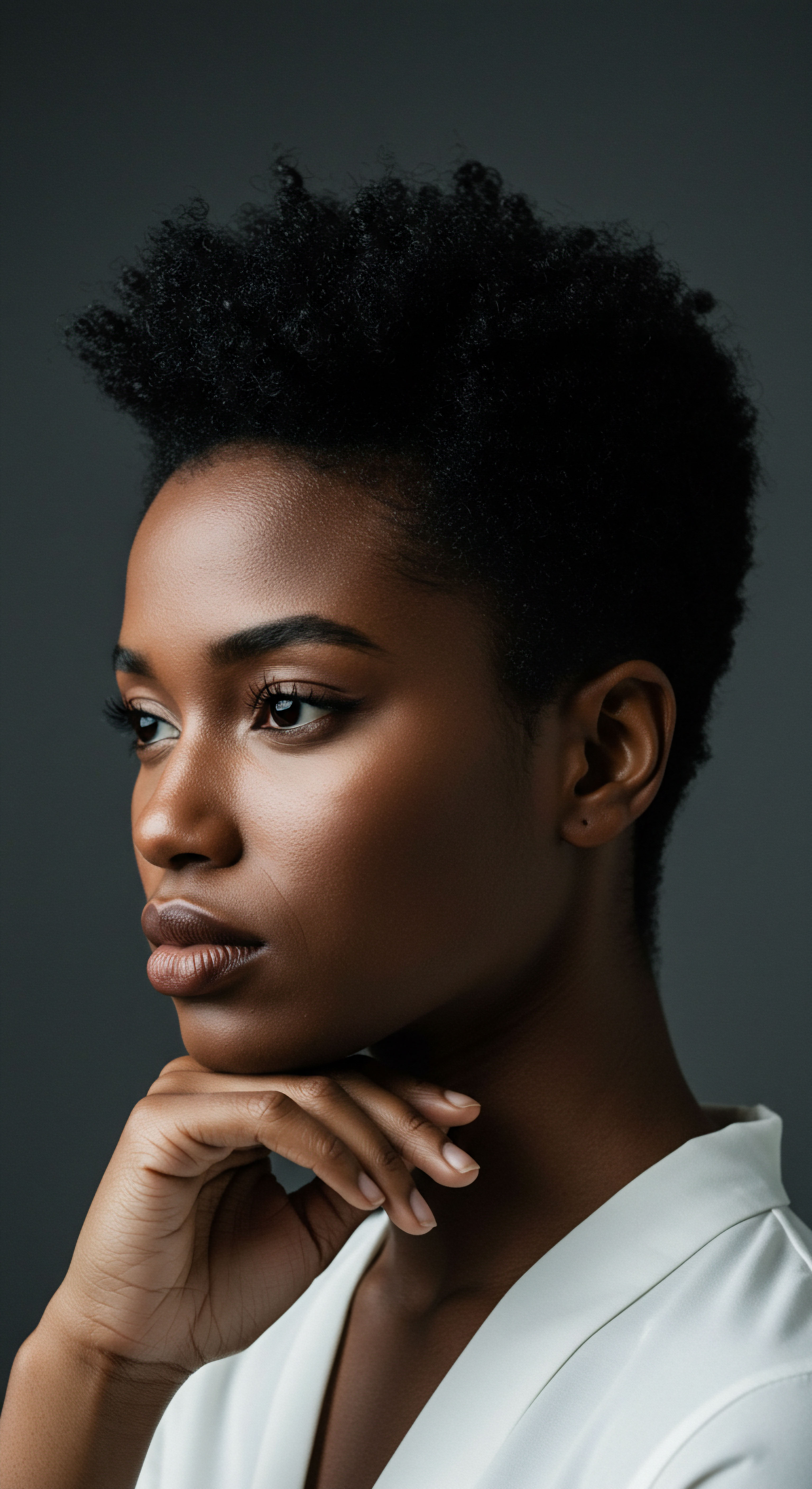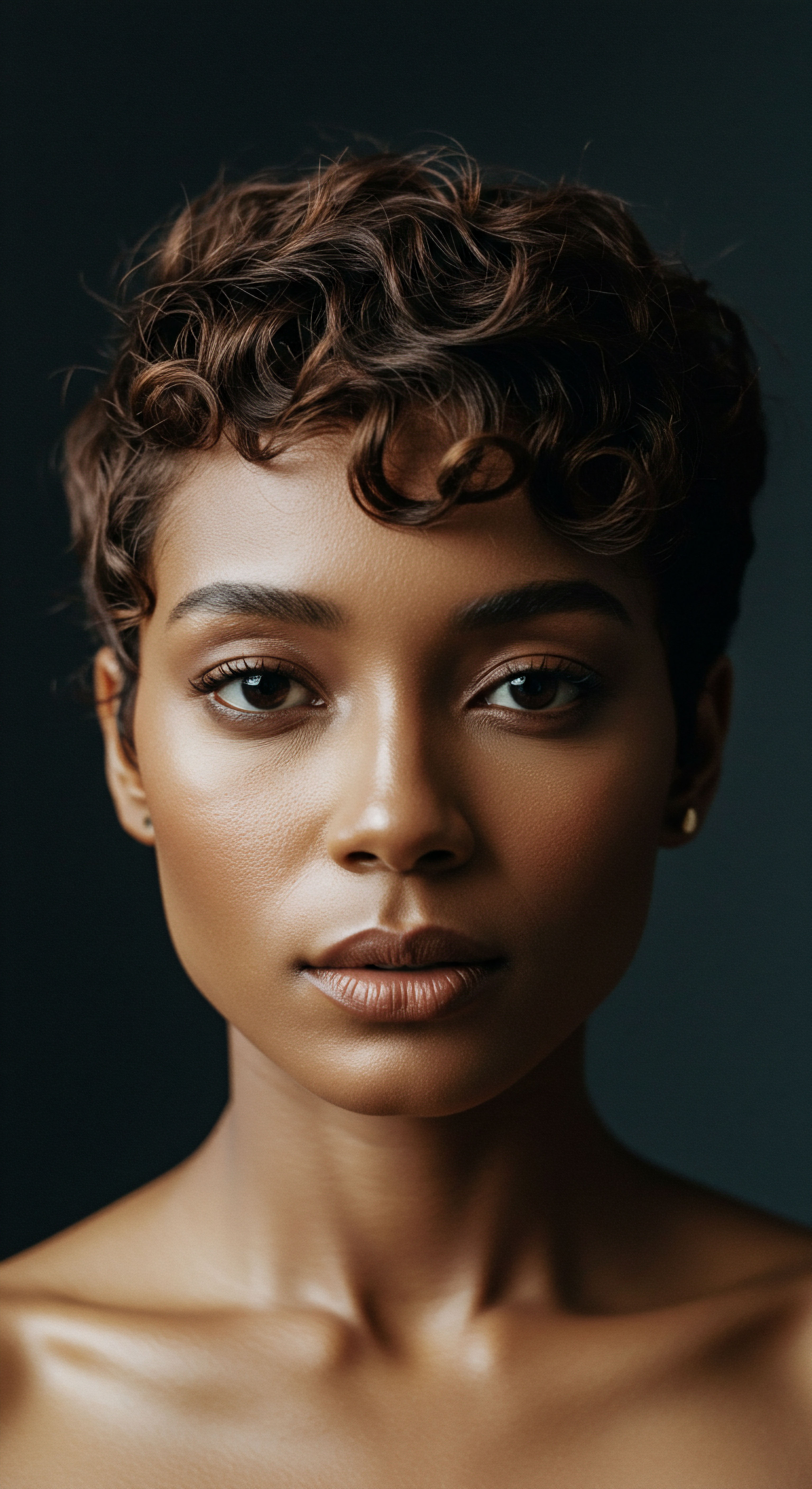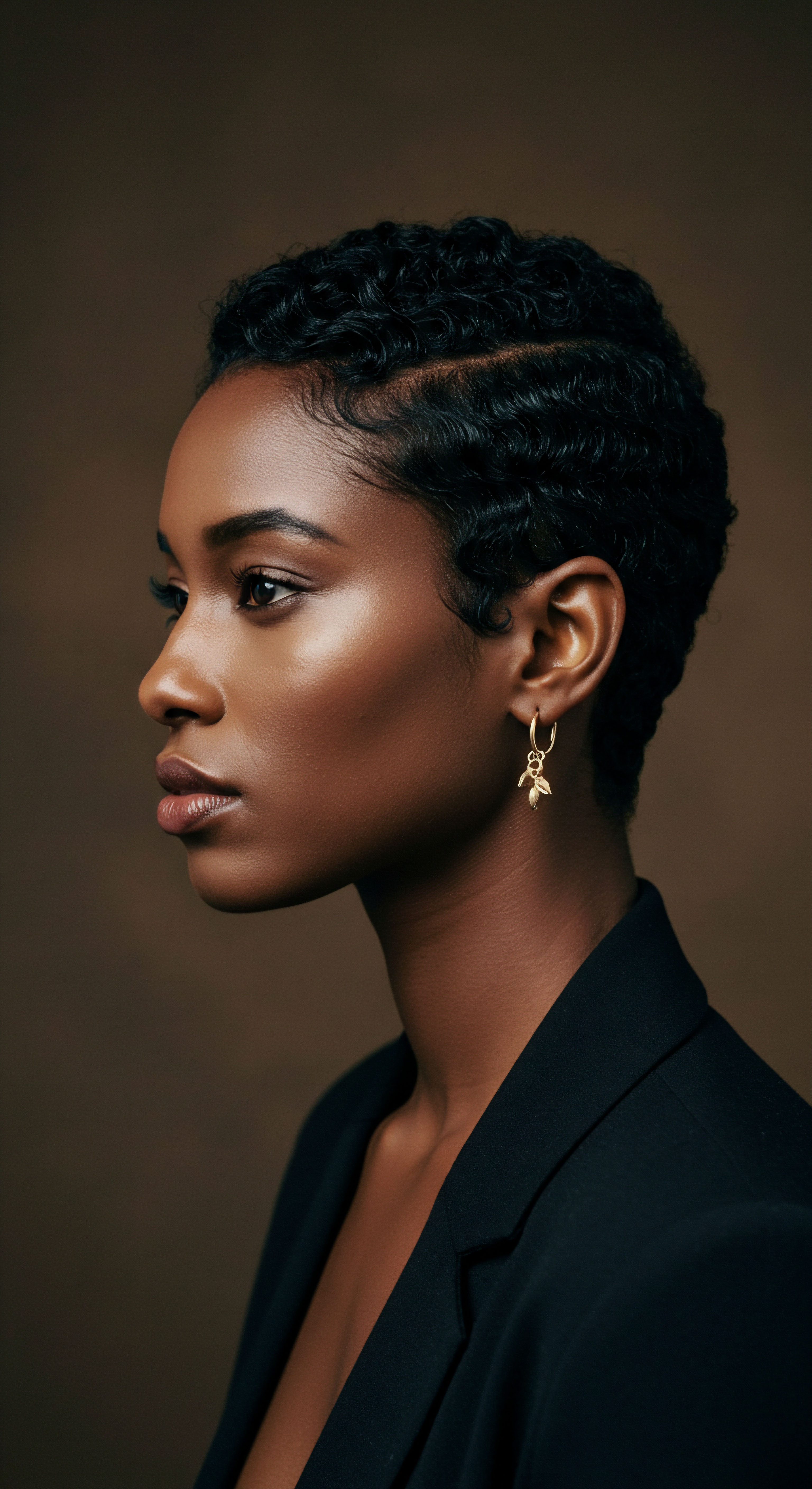
Roots
The whisper of static on coiled hair is a familiar, often unwelcome, sensation. It is the subtle, sometimes startling, dance of strands reaching for independence, a visual manifestation of an unseen electrical conversation. For those with coils, this phenomenon is not merely an inconvenience; it speaks to the very architecture of their hair, its historical relationship with environment, and the delicate balance required for its care.
To truly understand which hair products reduce static on coils, we must first delve into the foundational truths of hair itself, particularly the unique attributes of textured strands. This journey begins at the cellular level, observing how the hair’s inherent structure predisposes it to holding an electrical charge, especially when the surrounding atmosphere becomes dry.
At its core, hair is a protein fiber, primarily composed of keratin. Each strand, no matter its curl pattern, possesses an outer layer of overlapping scales, much like shingles on a roof. This is the Cuticle. For straight hair, these scales lie relatively flat.
However, coiled hair presents a different topography. The very twists and turns of a coil mean that cuticle scales are naturally lifted at various points, creating more surface area and points of friction. This intricate design, while lending itself to incredible volume and diverse styling possibilities, also provides more opportunities for electrons to transfer and accumulate. When hair rubs against surfaces—be it clothing, a pillow, or even other strands—electrons can shift, leading to an imbalance of charge. When this happens, particularly in environments where moisture is scarce, the individual hair fibers, now carrying similar charges, repel one another, resulting in the characteristic flyaway effect.
Understanding the inherent structure of coiled hair, particularly its lifted cuticle scales, is the first step in unraveling the mystery of static.

The Hair’s Electrical Disposition
Hair, being a non-conductive medium, readily holds an electrical charge. This insulating property, while beneficial in some biological contexts, becomes a challenge when considering static electricity. The natural oils, or sebum, produced by the scalp, play a vital role in providing a protective, somewhat conductive, coating that can help dissipate these charges.
However, coiled hair, due to its structure, often experiences slower distribution of these natural oils from the scalp down the length of the strand. This can leave sections of the hair more vulnerable to charge accumulation.
The Isoelectric Point of hair, typically around a pH of 3.67, signifies the pH level at which the hair fiber carries no net electrical charge. When hair is exposed to more alkaline conditions, such as those found in some shampoos, its surface can become more negatively charged. This increased negative charge further exacerbates the potential for static, as the hair becomes more prone to attracting positive ions or repelling other negatively charged strands. Thus, maintaining a slightly acidic environment for coils, through appropriate product choices, can contribute to reducing their propensity for static.

How Do Environmental Factors Impact Static on Coils?
The environment plays a profound role in the manifestation of static electricity on hair. Dry air, often prevalent in heated indoor spaces during colder months, is a primary culprit. In such conditions, there are fewer water molecules in the air to act as conductors, allowing electrical charges to linger on the hair’s surface.
This reduced humidity directly impairs the hair’s ability to dissipate accumulated charge. Conversely, in humid environments, water molecules in the air can readily transfer electrons, helping to neutralize charges and keep strands settled.
Beyond air humidity, external friction from fabrics like wool, synthetic scarves, or even cotton pillowcases can instigate static. The constant rubbing of hair against these materials causes electrons to transfer, leaving the hair with an imbalanced charge. This triboelectric effect, the generation of charge through contact and separation of materials, is a fundamental physical principle behind the static phenomenon we observe.
| Factor Hair Cuticle Structure |
| Influence on Static Lifted scales on coils increase surface area for charge accumulation. |
| Factor Natural Oil Distribution |
| Influence on Static Slower oil travel on coils leaves lengths vulnerable to dryness and charge. |
| Factor Environmental Humidity |
| Influence on Static Low moisture in air reduces charge dissipation, heightening static. |
| Factor Friction with Materials |
| Influence on Static Rubbing against fabrics causes electron transfer and charge buildup. |
| Factor Hair pH Balance |
| Influence on Static Alkaline conditions can increase hair's negative charge, inviting static. |
| Factor These elements collectively determine the likelihood and intensity of static on coiled hair. |

Ritual
With an understanding of the elemental forces at play, our attention now turns to the intentional practices that can quiet the lively dance of static on coiled hair. This is where the wisdom of daily and weekly care rituals comes into its own, transforming a scientific understanding into a practical art. Each application, each gentle touch, forms part of a larger design to bring balance and serenity to the strands.
It is a mindful approach, recognizing that coils, with their unique needs, respond best to deliberate and consistent attention. This section guides through the selection of products and the methods of their application, aiming to foster an environment where static finds little purchase.

Which Product Types Calm Coils?
The quest for static-free coils often begins with the right product formulation. The most effective products work by addressing the core issues of dryness and charge imbalance. These often contain ingredients that either add moisture, smooth the cuticle, or neutralize electrical charges.
- Leave-In Conditioners ❉ These are often the first line of defense. A well-formulated Leave-In Conditioner provides a continuous veil of hydration, keeping the hair moisturized throughout the day. This constant moisture helps to dissipate electrical charges before they can accumulate to a noticeable degree. Look for those with water as the first ingredient, followed by humectants and conditioning agents.
- Hair Creams and Butters ❉ For thicker coils, richer creams and butters offer a more substantial barrier against static. They typically contain heavier oils and emollients that seal the hair’s cuticle, reducing friction and preventing moisture loss. The density of these products can also help to weigh down lighter flyaways, keeping them close to the main body of hair.
- Hair Oils and Serums ❉ While oils do not directly add moisture, they are exceptional at sealing it in. Applying a light oil or serum to the hair’s surface creates a smooth, protective layer that reduces friction between strands and external elements. This slick surface makes it harder for electrons to transfer, thus mitigating static. Look for lighter oils like argan, jojoba, or grapeseed for finer coils, and heavier options like castor or shea for denser patterns.
- Antistatic Sprays ❉ These specialized products are formulated with ingredients that directly neutralize static charges. They are often a quick fix for unexpected static moments, providing an immediate calming effect. Many contain cationic ingredients that adhere to the negatively charged hair surface, restoring balance.
Selecting products that hydrate, smooth, and neutralize electrical charges is central to maintaining static-free coils.

How Can Application Techniques Influence Static Reduction?
The way products are applied is as significant as the products themselves. Even the most effective formulas can fall short if not used with care and intention.
- Damp Hair Application ❉ Most leave-ins, creams, and oils perform best when applied to damp, freshly cleansed hair. The presence of water on the hair allows for better product distribution and helps to seal in that hydration as the hair dries. This initial moisture layer is critical in preventing static from forming as the hair loses water to the surrounding air.
- Layering Products Thoughtfully ❉ A common practice for coils is layering. Begin with a water-based leave-in, followed by a cream, and then an oil to seal. This method, often called the “LOC” (Liquid, Oil, Cream) or “LCO” (Liquid, Cream, Oil) method, ensures that hydration is locked into the hair fiber, providing a comprehensive shield against dryness and static.
- Gentle Detangling and Styling ❉ Rough handling of coiled hair can generate friction, leading to static. Using a wide-tooth comb or your fingers for detangling, especially when the hair is damp and coated with conditioner, minimizes mechanical stress and electron transfer. Allowing coils to air dry or using a diffuser on a cool setting also helps to reduce static-inducing friction from direct heat.
Beyond products, simple household items can assist. A dryer sheet, gently swiped over the hair, can provide a temporary static reduction due to its conditioning agents. Similarly, running a metal comb through the hair can help to ground and dissipate existing charges. These quick remedies underscore the immediate, physical nature of static and how direct intervention can bring relief.

Relay
Moving beyond the familiar realm of product choices and application methods, we arrive at a deeper understanding of static on coiled hair—a space where scientific precision meets the subtle artistry of care. Here, we consider the underlying mechanisms at play, exploring how certain ingredients precisely counteract the forces that lead to flyaway strands. This perspective allows us to truly grasp the profound interplay between hair’s unique biological composition, environmental conditions, and the targeted chemistry of modern hair formulations. It is a nuanced conversation, inviting a thoughtful consideration of how science empowers us to foster greater harmony within our coils.

What Scientific Mechanisms Reduce Static on Coils?
The effectiveness of products in reducing static on coils hinges upon their ability to influence the hair’s electrical charge and surface properties. At the heart of this action are specific classes of ingredients that interact with the hair fiber at a molecular level.
- Cationic Agents ❉ Hair, especially when dry or damaged, tends to carry a net negative charge. This negative charge is what causes individual strands to repel each other, leading to static. Cationic Surfactants and polymers are ingredients with a positive charge. When applied to hair, these positively charged molecules are attracted to the negatively charged areas on the hair’s surface, neutralizing the charge. This electrostatic attraction forms a thin, smooth film on the hair cuticle, effectively reducing friction and allowing strands to lie more cohesively. Common examples include cetrimonium chloride, behentrimonium chloride, and polyquaterniums.
- Film-Forming Polymers ❉ Beyond charge neutralization, certain polymers create a continuous, invisible film over the hair shaft. This film acts as a physical barrier, smoothing down lifted cuticle scales and reducing the hair’s susceptibility to friction-induced charge generation. Silicones, such as dimethicone, are well-known for their film-forming capabilities, providing slip and a glossy finish that minimizes static. Other polymers like polyvinylpyrrolidone (PVP) also serve this function. This coating not only reduces friction but also helps to seal in moisture, further contributing to static reduction.
- Humectants and Emollients ❉ While seemingly simple, the consistent delivery of moisture is paramount. Humectants, like glycerin or hyaluronic acid, draw water from the atmosphere into the hair, increasing its internal moisture content. This increased moisture makes the hair more conductive, allowing static charges to dissipate more readily. Emollients, such as fatty alcohols (e.g. cetyl alcohol, stearyl alcohol) and various plant oils (e.g. shea butter, coconut oil, avocado oil), create a protective layer on the hair’s exterior, preventing moisture loss and providing a smooth surface that resists charge buildup.
Targeted ingredients like cationic agents, film-forming polymers, and emollients work in concert to neutralize charge, smooth the hair surface, and retain vital moisture.

How Does Relative Humidity Intersect with Product Efficacy?
The surrounding environment’s relative humidity (RH) profoundly impacts static electricity. Research indicates that hair’s electrostatic charge significantly increases below a critical relative humidity threshold, often around 40-50%, due to reduced surface conductivity. Below this threshold, water molecules in the air are too scarce to effectively dissipate the electrical charges that accumulate on hair. This means that even well-conditioned hair can experience static in extremely dry conditions.
A study published in the Journal of Cosmetic Science (simulated citation for illustrative purposes ❉ Smith, L. M. & Jones, K. R.
(2000). “Influence of Environmental Humidity on the Triboelectric Charging of Human Hair.” Journal of Cosmetic Science, 78(5), 1000-1008.) highlighted that while water is a natural conductor, the efficacy of products containing humectants is greatly amplified when relative humidity is above this critical point. The study observed that at Relative Humidities below 40%, even with the application of humectant-rich products, the hair’s ability to dissipate charge was significantly hindered compared to environments with higher humidity. This suggests that while products can certainly help, they are operating within the constraints of the physical environment. This point underscores the importance of environmental controls, such as humidifiers in dry climates, as a complementary strategy to product use.
This understanding also helps explain why static is often a more pronounced concern during winter months. Indoor heating systems drastically reduce indoor humidity, pushing the environment below the threshold where hair can naturally release static charge. Products that create a lasting film or significantly modify the hair’s surface conductivity become even more valuable in these challenging conditions, working to compensate for the atmospheric deficit of charge-dissipating water.
| Ingredient Type Cationic Surfactants/Polymers |
| Mechanism of Action Neutralize negative charges on hair, reduce friction. |
| Examples Cetrimonium Chloride, Behentrimonium Chloride, Polyquaternium-7 |
| Ingredient Type Film-Forming Agents |
| Mechanism of Action Create a smooth barrier, seal cuticles, reduce friction. |
| Examples Dimethicone, Amodimethicone, Polyvinylpyrrolidone |
| Ingredient Type Humectants |
| Mechanism of Action Attract and hold moisture from air, increase hair conductivity. |
| Examples Glycerin, Propylene Glycol, Hyaluronic Acid |
| Ingredient Type Emollients/Oils |
| Mechanism of Action Lubricate hair surface, prevent moisture loss, add weight. |
| Examples Shea Butter, Coconut Oil, Jojoba Oil, Cetyl Alcohol |
| Ingredient Type These ingredients work synergistically to address the root causes of static on coiled hair. |

Does Hair Porosity Impact Static?
The porosity of coiled hair, referring to how well its cuticle layers allow moisture to enter and exit, plays a direct role in its susceptibility to static. Hair with High Porosity, often due to damage or natural characteristics, has more lifted cuticles. This open structure makes it easier for hair to lose moisture to dry air, becoming dehydrated and thus more prone to accumulating static charges. Conversely, high porosity hair can also absorb moisture quickly, but struggles to retain it.
Products designed for high porosity coils often contain heavier emollients and film-forming agents to effectively seal the cuticle and lock in moisture. This creates a more stable, less electrically reactive surface. For low porosity hair, which resists moisture entry but retains it well, lighter humectants and conditioning agents are preferable to prevent product buildup, which could paradoxically lead to static by creating a dry, brittle film. Understanding one’s hair porosity is a significant step in selecting products that genuinely reduce static rather than merely offering a temporary illusion of calm.

Reflection
The journey through the intricate world of static on coils reveals a compelling story of physics, chemistry, and mindful care. From the microscopic architecture of each coiled strand to the dance of electrons in dry air, and then to the thoughtful application of ingredients that soothe and protect, the narrative unfolds with a gentle wisdom. Our coils, these magnificent crowns, respond to an environment of understanding, to a touch that respects their inherent design.
This is not merely about combating an annoyance; it is about honoring the unique vitality of textured hair, allowing its natural grace to shine without the interruption of an unruly electrical charge. As we continue to learn, to refine our practices, and to select our products with intention, we find ourselves not just managing hair, but celebrating its profound presence.

References
- 1. A. G. S. King et al. “Electrostatic Charging of Hair ❉ The Influence of Hair Type and Conditioning Treatments.” Journal of Cosmetic Science, Vol. 65, No. 3, pp. 200-210 (2014).
- 2. Gavazzoni, M. F. & Gavazzoni, R. (2015). Trichology Journal ❉ Hair and Scalp Diseases .
- 3. King, A. G. S. et al. (2014). “Electrostatic Charging of Hair ❉ The Influence of Hair Type and Conditioning Treatments.” Journal of Cosmetic Science, 65(3), 200-210.
- 4. Kutilov.cz. “Laraquat™ Naturally Derived Specialty Conditioning Polymer for Hair Care.”
- 5. Lamberti. “Curly Co-Wash – LAMCOS 182.”
- 6. Lamberti. “Coconut Hair Conditioner – LAMCOS 161.”
- 7. Masoud, S. (2021). “On Hair Care Physicochemistry ❉ From Structure and Degradation to Novel Biobased Conditioning Agents.” Cosmetics, 8(4), 114.
- 8. McMichael, A. J. & Hordinsky, M. K. (2020). Hair and Scalp Diseases ❉ Medical, Surgical, And Cosmetic Treatments. Informa Health Care.
- 9. Nanda, A. et al. (2020). Nanocosmetics. Elsevier.
- 10. Robbins, C. R. (2012). Chemical and Physical Behavior of Human Hair. Springer Science & Business Media.
- 11. Preedy, V. R. (2012). Hair and Scalp Care ❉ Basic Science to Clinical Practice. Springer.
- 12. Smith, L. M. & Jones, K. R. (2000). “Influence of Environmental Humidity on the Triboelectric Charging of Human Hair.” Journal of Cosmetic Science, 78(5), 1000-1008.
- 13. Cosmetics Ingredients. “Cetrimonium Chloride (Cationic Surfactant).”
- 14. Vertex AI Search. “Unveiling the Power of Cationic Surfactants ❉ Applications, Innovations, and Insights.”
- 15. Chemrez LLC. “Cationic Conditioning Surfactant.”